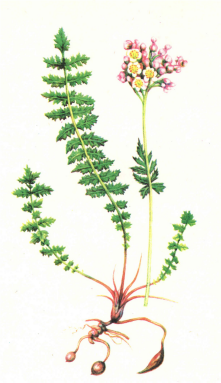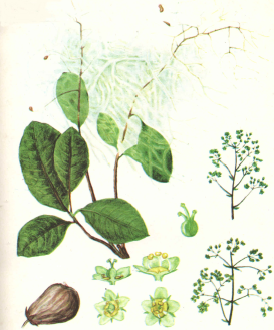On birch trunks, the parasitic fungus chaga (Inonotus obliquus (Pers.) Pilat., forma sterilis), also known as the tilted polypore, frequently develops. This fungus belongs to the basidiomycetes.
The spores, dispersed in the air, land on damaged areas of tree bark (broken branches, frost damage, etc.) and begin to germinate, forming mycelium. The fungal threads of the mycelium penetrate the wood, gradually destroying it and causing white heart rot. At the initial site of spore penetration, black growths, called chaga, develop from the fungus hyphae. These growths expand over 10–15 years, reaching substantial sizes and weights of 3–5 kg or more. These formations represent the sterile mycelium of the fungus, while the fruiting body producing basidiospores develops under the bark and remains hidden.

Chaga is harvested in forests from old, growing birches or felled trees in logging areas. The fungus does not develop on young birches. On deadwood or fallen trees, chaga decomposes, and other non-medicinal fungi grow in its place. At the base of old birches, one may find decayed, crumbly, uniformly black chaga growths, which are unsuitable for collection.
Chaga can be collected year-round, but it is easier to locate growths during the leafless season, from autumn to spring. Growths on the tree have round, elongated, or oval shapes, sometimes appearing as narrow, long formations along cracks, up to 1–1.5 m in length. The growths are dense and, when cut, show three layers:
The outer layer: black, knobby, and cracked.
The middle layer: very dense, brown, and granular in fracture, forming the bulk of the chaga.
The inner layer: loose, extending into the wood.
The growths are chopped off with an axe along the trunk, and the loose inner part, unsuitable for collection, is removed along with attached pieces of bark and wood. The harvested chaga is cut into pieces 3–6 cm in size and dried in the air or at a temperature not exceeding 50–60°C.
Chaga contains no alkaloids or glycosides. Its activity is attributed to a water-soluble pigment fraction containing a chromogenic polyphenol-carbon complex (20%) that forms colloidal aqueous solutions. The ash content is 12.3%, rich in manganese, which may contribute to its therapeutic effects by activating enzymes. Chaga also contains resin (not fully studied), agaricinic acid, and other substances.
Chaga is consumed internally as a semi-thick extract with added cobalt salts (Befungin). It is prescribed as a symptomatic remedy for malignant tumors of various localizations when surgical intervention or radiation therapy is not possible. Chaga improves patients’ well-being and is also recommended for gastrointestinal disorders.
The extract, diluted in boiled water, is taken at 3.5 g per day. A homemade infusion can be prepared as follows: Fresh chaga is washed and grated. Dried chaga is softened by soaking in boiled cold water for 4 hours and then grated. One part grated chaga is combined with 5 parts boiled water at 40–50°C (no higher) and left to steep for 48 hours. The liquid is then strained, the residue is squeezed, and the water used for soaking is added. This infusion can be stored in a cold place for 4 days. It is consumed in three glasses per day, divided into several doses, half an hour before meals.








